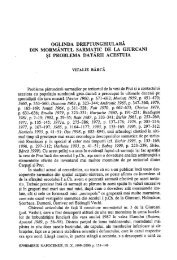EPHEMERIS NAPOCENSIS - Institutul de Arheologie Åi Istoria Artei
EPHEMERIS NAPOCENSIS - Institutul de Arheologie Åi Istoria Artei
EPHEMERIS NAPOCENSIS - Institutul de Arheologie Åi Istoria Artei
You also want an ePaper? Increase the reach of your titles
YUMPU automatically turns print PDFs into web optimized ePapers that Google loves.
ARCHAEOLOGICAL AND EPIGRAPHICAL NOTES<br />
COMMENTARIA ARCHAEOLOGICA ET HISTORICA (I)<br />
Aurel Rustoiu 1<br />
Abstract: The first note is discussing the Celtic grave with a helmet from Ciumeşti and the significance of<br />
the Greek bronze greaves which belong to this burial. During the 50 years which passed since its discovery,<br />
the aforementioned grave generated numerous comments, interpretations and scientific <strong>de</strong>bates. The note<br />
is a synthesis of the information regarding its context of discovery, the stages of publication of the inventory<br />
and the successive theories concerning the chronology and interpretation of the grave. A recent analysis has<br />
<strong>de</strong>monstrated that the burial can be dated to the LT B2-C1 (or more likely only to the LT C1) and very<br />
probably belonged to a Celtic warrior from the Carpathian Basin who was a mercenary in the eastern<br />
Mediterranean region in the second half of the 3 rd century BC. Starting from these aspects, the Greek bronze<br />
greaves belonging to the funerary inventory, alongsi<strong>de</strong> other items of LT military equipment, are analysed<br />
in <strong>de</strong>tail. The artefacts played an important role in <strong>de</strong>fining a particular warlike i<strong>de</strong>ntity in comparison<br />
with the military elites of the eastern Mediterranean.<br />
The second note comprises an evaluation of the ol<strong>de</strong>r or more recent Transylvanian discoveries belonging<br />
to the Pa<strong>de</strong>a-Panagjurski kolonii group: funerary contexts or isolated finds including specific weaponry or<br />
harness fittings. They illustrate a concentration of the burials of Pa<strong>de</strong>a-Panagjurski kolonii type in southwestern<br />
Transylvania, more precisely in an area related to the centre of power of the Dacian kingdom<br />
prior to and during the rule of Burebista. At the same time, some burials point to an extension of this<br />
phenomenon in farther areas from central or northern Transylvania, up to the upper Tisza, these regions<br />
being very probably taken over and controlled by Dacian kings. Chronologically, most of these discoveries<br />
can be dated to the LT D1, the latest dated burials belonging to the Augustan period.<br />
Keywords: Ciumeşti, graves, greaves, helmets, sica, Pa<strong>de</strong>a-Panagjurski kolonii<br />
1. The grave with a helmet from Ciumeşti – 50 years from its discovery.<br />
Comments on the greaves 2<br />
The well-known grave from Ciumeşti (Satu Mare County, Romania), containing an<br />
iron helmet having a realistic-ma<strong>de</strong> bronze bird of prey fitted on the calotte, was discovered 50<br />
years ago, on 10 August 1961. The helmet is a unique artefact amongst the La Tène finds from<br />
Europe due to its outstanding features. As a consequence it was inclu<strong>de</strong>d in numerous exhibitions<br />
and catalogues, as well as in syntheses concerning Celtic art and civilization. Unfortunately<br />
the burial was inci<strong>de</strong>ntally discovered and its inventory was recovered and published in successive<br />
stages. This situation led to the appearance and perpetuation of several confusions regarding the<br />
1<br />
Institute of Archaeology and History of Art Cluj‐Napoca, Romanian Aca<strong>de</strong>my Cluj Branch, M. Kogălniceanu<br />
str. 12–14, 400084, Cluj‐Napoca, Cluj county, RO; e-mail: aurelrustoiu@yahoo.com.<br />
2<br />
This work was supported by a grant of the Romanian National Authority for Scientific Research, CNCS –<br />
UEFISCDI, project number PN-II-ID-PCE-2011-3-0278.<br />
Ephemeris Napocensis, XXII, 2012, p. 159–183















